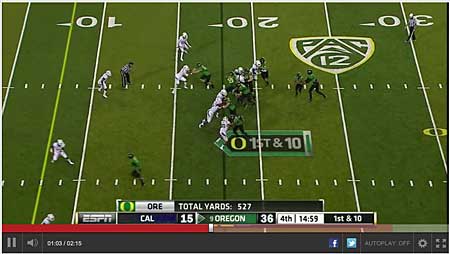ESPN Partners with Elemental for Video-on-Demand
Elemental Technologies builds on-demand and real-time encoding systems that use NVIDIA graphics processing units (GPUs) in addition to traditional CPUs in their encoders. They've been around since 2006, but seem to be gaining significant momentum with broadcasters and mainstream media. For example, Elemental was featured in a BusinessWeek article a few weeks ago, which doesn't often happen to companies from the streaming media sandbox.
The company also has some impressive wins with international sports sites, announcing deals with UK-based Eurosport, Brazil-based Terra Networks, French broadcaster TF1, and Italian streaming producer Deltatre in fall 2011. For roller-derby fans, Elemental also inked a deal to broadcast pay-per-view broadcasts this fall and winter.
On November 30, 2011, Elemental grabbed the big brass ring of sport sites, announcing a deal with ESPN. ESPN has a strict non-endorsement policy, and their comments are limited to this statement released by Elemental:
Elemental is working with ESPN, the worldwide leader in sports programming, to create the on-demand video offered on the ESPN family of websites and ESPN iPhone, iPad, and Android applications. ESPN is using Elemental Server to create 14 distinct video outputs for adaptive bit rate playback on each of these platforms. This enables the sports network to put high-quality digital highlight packages online faster than ever before to satisfy fan demand.
In the ESPN deployment, Elemental Server quickly converts a variety of inputs, including MPEG-2, DVCPRO HD, and MOV files, to a wide range of web-based outputs. These assets are made immediately available for viewers to watch any time on their platform of choice. In addition to the ESPN.com flagship site, Elemental Server also powers the video for ESPN's mobile applications and regional properties, such as ESPN New York and ESPN Dallas. Foreign language-speaking fans can find Elemental video on the internationally-focused ESPN Deportes.
I spoke with Co-founder and CEO Sam Blackman about the success the company has achieved over the last few months.
 SM: Sam, there are lots of live and on-demand hardware encoders out there; what's the elevator pitch as to why your products are better.
SM: Sam, there are lots of live and on-demand hardware encoders out there; what's the elevator pitch as to why your products are better.
Blackman: There are three key elements to our product offering. First, we use GPUs in our core architecture, which gives us unmatched density and encoding speed. Still, we're essentially a software solution, which makes us future proof as compared to products using codec-specific hardware encoders.
Second, we build our systems on Linux, which is more reliable and easier to manage than Windows. Since most data-center apps are running on Linux, our systems more closely match the rest of data center architecture.
Finally, we build all of our codecs from scratch, and all key image processing functions like deinterlacing, color correction, and scaling, as well. This lets us innovate faster than competitors who license technologies from third parties, and don't completely control their development road maps. We can also move more quickly to address any problems in the field since we never have to wait for a third party to fix their code.
SM: ESPN is getting into adaptive streaming in a big way. How does your architecture support this?
 Blackman: Again, because we control all elements of the product, we can optimize our technology for high-speed adaptive encoding. For example, our encoding pipeline reuses functions like source footage decoding and deinterlacing for all renditions, and then scales and encodes each stream individually. Technologies that rely on third-party codecs or hardware may not have that flexibility.
Blackman: Again, because we control all elements of the product, we can optimize our technology for high-speed adaptive encoding. For example, our encoding pipeline reuses functions like source footage decoding and deinterlacing for all renditions, and then scales and encodes each stream individually. Technologies that rely on third-party codecs or hardware may not have that flexibility.
We also work closely with Adobe, Microsoft, and Apple to stay ahead of changes in their adjustable bitrate technologies. For example, with iOS 5.0, you can now produce multiple audio and video tracks; we've been doing that for Smooth Streaming, so it was relatively straightforward to port it over to HTTP Live Streaming (HLS).
Encoding solutions that use H.264 encoding chips might need a firmware update to supply the same functions, while those using third party software-based codecs will need an update from their supplier. Because we own the entire pipeline, we can be faster and more responsive.
SM: Everyone claims that they have the fastest encoding speed; do you have any third-party references that can back that up?
Blackman: You mean other than four of the world's largest sports broadcasters choosing our technology? [laughs] Actually, in addition, our live and on-demand encoders were the fastest performers in the comparative tests performed by Tim Siglin in his Best Workflows Q1 2011 Encoding and Transcoding Solutions White Paper. You can download the white paper from our web site. [Tim Siglin, a contributing editor to StreamingMedia.com, wrote the white paper for consulting firm Transitions, Inc., independent from his work for this website, and it does not necessarily reflect the views of StreamingMedia.com. The white paper can also be downloaded directly from Transitions' Workflowed blog.—Ed.] Tim reported that we were 2 to 3 times faster than our competitors, and some of our customers report up to 10 times faster.
SM: How many processing chips are installed in your typical encoder?
Blackman: The systems that ESPN are buying have four processors total: two traditional Intel 6-core Westmere CPUs and two NVIDIA GPUs, each with 512 discrete processors. Having both types of processors onboard lets us allocate work to the type of processor that performs it most efficiently. For example, for computationally intense functions like deinterlacing, motion estimation, and deblocking, we use the GPUs, which takes a ton of work off the CPUs. CPUs are better at serial processes like encoding CABAC, so we use the CPU for these functions.
SM: Other than sheer processing power, are there any other advantages from using a GPU in your encoder?
Blackman: With our live products, we've invested heavily to match the workflows required by our broadcast customers. For example, our controls and APIs let them schedule the encoder to start and stop a live event, with real time advertising insertion and other monetization-oriented features. In these live broadcasts, the GPU's come in quite handy for their original, graphic-oriented functionality, enabling features like real time alpha blending and the like.
SM: How do your customers typically integrate your system into their encoding and delivery workflows?
Blackman: Our systems have a user-friendly, web-based user interface to create presets and drive individual encodes, and our systems can also monitor and deliver to watch folders. Most clients integrate using our REST API, which uses XML commands to tell the system where to retrieve the files, which profiles to apply, and where to deliver them.
Related Articles
Years into the TV Everywhere discussion, viewers are still blocked by password requirements. ESPN's president lashes out.
10 Mar 2014
In the Streaming Media East 2013 opening day keynote, ESPN explained why online video needs to be better than standard television.
21 May 2013
The 2012 Summer Games could be the biggest streaming event ever, as more countries take part and mobile viewers tune in.
10 Apr 2012
The leading sports website upgrades its video streams to HD and adaptive bitrate. Learn what motivated the changes.
25 Aug 2011
The video processing company will work jointly with thePlatform to serve Comcast's growing needs with mobile devices.
25 Jul 2011
Elemental announces new investment and both it and Media Excel push forward with expansion plans for their hardware and software transcoding products
25 Jan 2011